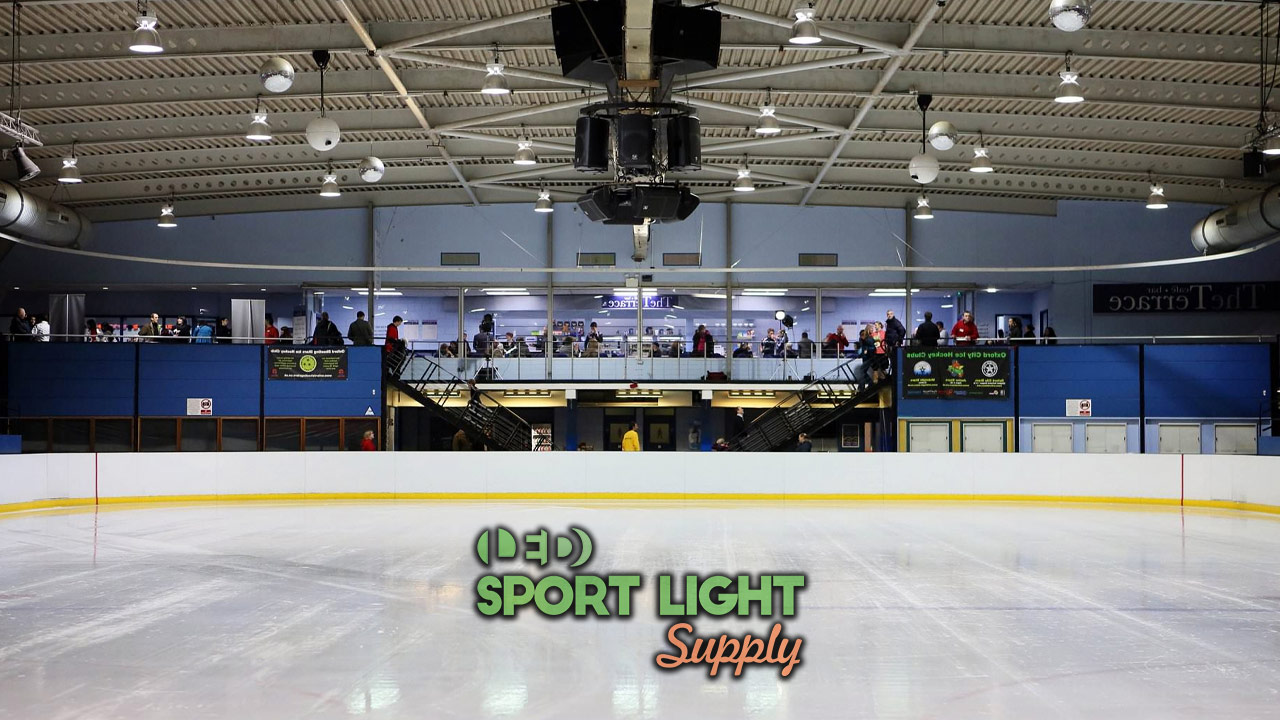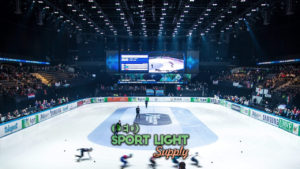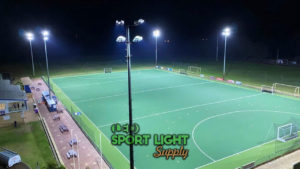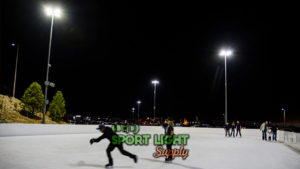The importance of meeting lighting requirements for ice hockey rinks
Hockey players shape the hockey we all play and enjoy watching. But when a player is skating to score a goal or lifting the puck for a flip pass, the quality of the lighting system can have a positive or negative effect.
The hockey world that we have today has a set of rules to ensure visual comfort and players’ safety. But to set up the lighting requirement, you need to perform many tests in the ice arena. In fact, sufficient lighting is so only when specific values are met.
When it comes to the hockey rink, six critical factors determine how satisfying a lighting system is. Even though the regulation may change the limits from location to location, the six factors are:
- luminance distribution
- light intensity
- glare
- lighting direction
- light quality (color temperature and CRI)
- reflection on the artificial ice
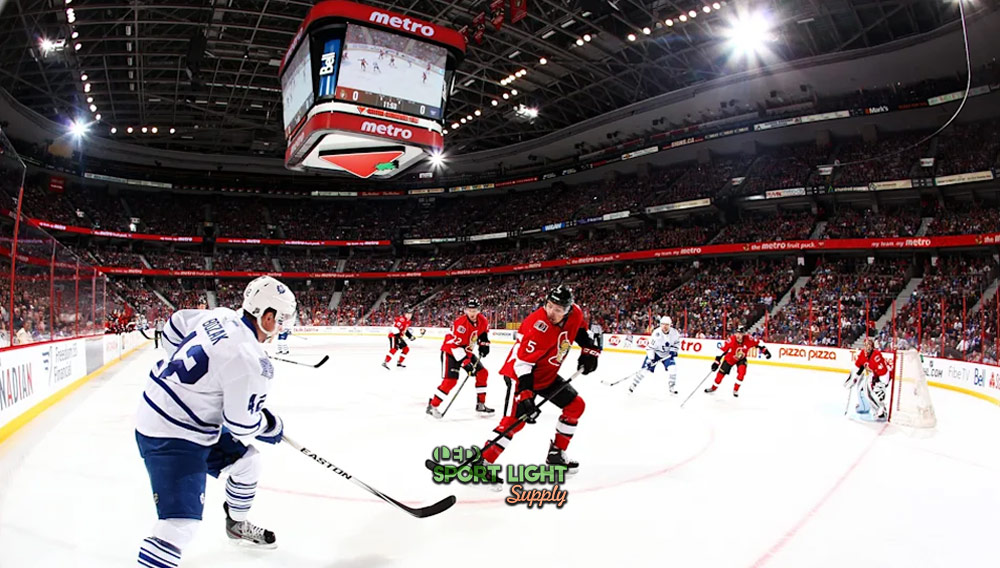
What is the ice rink lighting requirement?
1. LES lux or footcandle recommendations
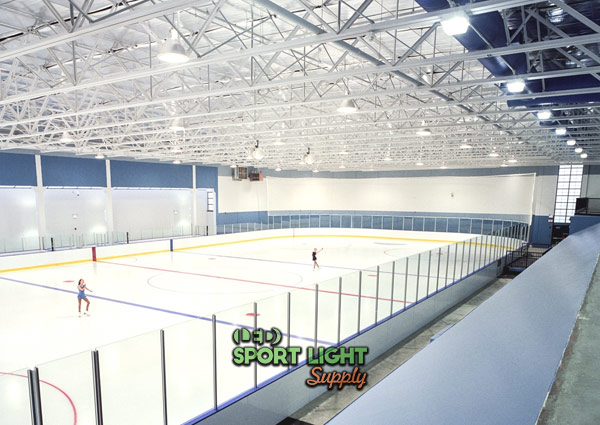 When shopping for your new lighting, you might have stumbled on one of the most crucial metrics for brightness. That is, the lumen. Maybe, you would like to compare different LED lights and use the lumen value for a sound judgment. However, as soon as you put the light in the hockey hall, the distance might be too great for the light to be effective. This is why we need another way to evaluate how much light falls on a given surface area (illuminance).
When shopping for your new lighting, you might have stumbled on one of the most crucial metrics for brightness. That is, the lumen. Maybe, you would like to compare different LED lights and use the lumen value for a sound judgment. However, as soon as you put the light in the hockey hall, the distance might be too great for the light to be effective. This is why we need another way to evaluate how much light falls on a given surface area (illuminance).
While le lumen is the raw, potential output of a light source, lux refers to a value that depends on the distance. As you increase the distance, the lux value decrease, and vice versa. So, the standard lux value you find in the various guidelines refers to the ultimate reading you need to achieve after installing all the lights. In the US, the lux requirement may appear as a footcandle (fc) standard. In this case, 1 fc = 10.76 lux.
a) horizontal lux requirement
In every regulation, you find horizontal and vertical illuminance values. In fact, knowing how much light reaches the ice rink in every dimension is important. Mainly because each fixture may have a different beam angle or position.
At the same time, several horizontal illuminance values are available. Depending on the level of competition, the lighting requirement change. After all, pro hockey players disputing the playoffs need more brightness than children training in their leisure time.
The standard guide divides the illuminance values into lighting classes. For the professionals, a minimum value of 1,200 lux (111,5 fc) is necessary. Smaller leagues require 800 lux or 74.3 fc. For local and regional matches in the lower ice hockey series, 500 lux (46,4 fc) will suffice. Lastly, a minimum of 250 lux (23 fc) is recommendable for training and recreational use.
b) vertical lux requirement
The lighting designer plans and designs the positioning of the lights. So, the vertical illuminance changes accordingly. For example, mounting the lamps all around a vaulted ceiling can give the ice arena a more welcoming look. A couple of big spot light may illuminate the center zone for the first face off. Yet, the lights must comply with the requirement for vertical illuminance.
The four values are the following. Starting with the higher lighting class:
- 800 lux (74.3 fc) for professional championship leagues
- 500 lux (46,4 fc) for junior championship leagues
- 300 lux (27,9 fc) for 2nd division and local tournaments
- no lux or fc requirement is necessary for training
2. Lighting uniformity requirement
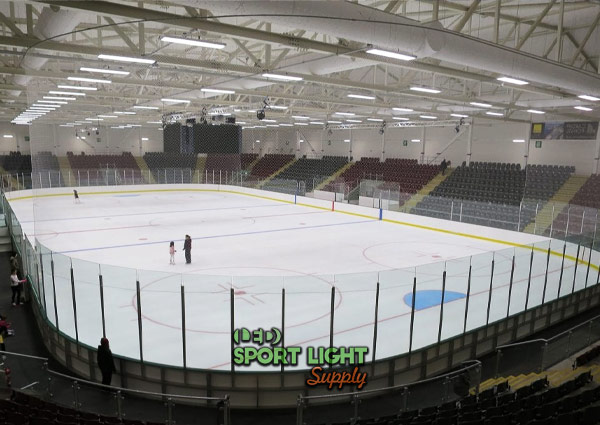 Lighting uniformity is critical for ensuring an even light distribution. As the winger attacks and the defense strides towards him, the perception of safety may vary. In fact, the lighting condition of one spot may not be as good as the one in the adjacent zone.
Lighting uniformity is critical for ensuring an even light distribution. As the winger attacks and the defense strides towards him, the perception of safety may vary. In fact, the lighting condition of one spot may not be as good as the one in the adjacent zone.
The number of luminaires necessary for improving uniformity can be a factor. Also, the spacing criterion for optimal uniformity depends on the ice hall area. In general, the spacing between luminaries should not exceed the mounting height.
Overall and longitudinal uniformity
For the ice arena owner, uniformity is reached when two values are met. They are the overall and longitudinal uniformity values. At its very best, the ratio between each spot on the ice rink must comply with the requirement. But to speed up things, you divide the max lux value from the readings on the ice and divide it by the min value. This calculation gives you the longitudinal uniformity value (Ud). Then, you get all the readings and take the average to divide the min reading by the average. Now you have the overall uniformity value (Uo).
In hockey, horizontal Ud should be at least 0,6 for pro events, 0,5 for minor matches, and 0,4 for training. Vertical Ud must exceed 0,5 for the top, 0,4 for the middle, and 0,2 for the low level of competition. Similarly, horizontal and vertical Uo should be 0,8 and 0,7 for pro leagues, 0,7 and 0,6 for minor championship leagues, 0,7 and 0,4 for junior leagues respectively. Training should have a horizontal Ud = 0,4 and Uo = 0,6, but vertical uniformity is not required.
3. Color temperature regulations
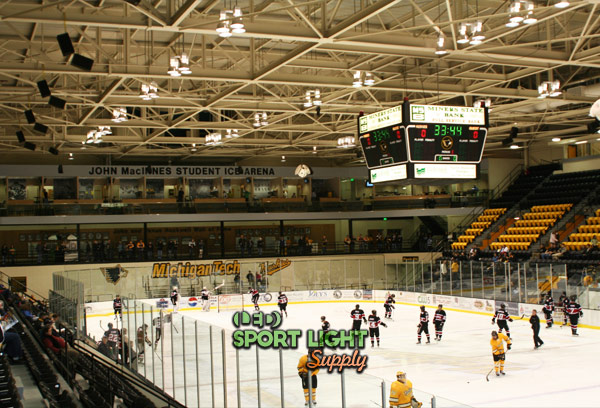 LED solutions are optimal because they let you change color and color temperature. Expressed in Kelvin (K), the color temperature usually ranges between 2,000 K (or candle light) to 10,000 K (like the blue sky). Most products on the market have a 2,700K light, which is a warm and inviting light. But for hockey, higher color temperatures are necessary.
LED solutions are optimal because they let you change color and color temperature. Expressed in Kelvin (K), the color temperature usually ranges between 2,000 K (or candle light) to 10,000 K (like the blue sky). Most products on the market have a 2,700K light, which is a warm and inviting light. But for hockey, higher color temperatures are necessary.
The standard of color temperature requires at least 3,000 K for training and low-level competitions. In this case, the higher threshold is 5,000 K, which resembles daylight. Instead, broadcasters need higher values. So, for junior championship leagues, the color temperature range is 4,000-6,000 K. The professional championship league requires a minimum of 5,000 K, up to 6,500 K.
4. Glare control
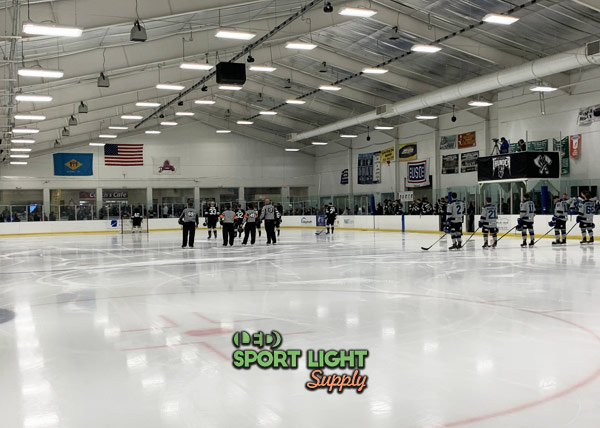 As the artificial ice reflects the beams of lights, a GR-method is used for glare control. For reference, the CIE publication 112-1994 contains valuable information on how to control glare. Similarly, the standard EN 12464-1 offers the UGR-method to calculate this metric.
As the artificial ice reflects the beams of lights, a GR-method is used for glare control. For reference, the CIE publication 112-1994 contains valuable information on how to control glare. Similarly, the standard EN 12464-1 offers the UGR-method to calculate this metric.
In brief, LED lights are intense light sources and can easily replace old HID lamps. But they need to be shielded properly to avoid glare. No fixture should blind a player as glare can result in body contact, hitting the goal cage, or the boards by mistake.
Glare may occur at a certain viewing angle. So, measures must be taken to ensure a glare-free environment at the height of 1,5 m in any part of the hockey rink. Of course, the lighting design should consider the spectators as well.
Usually, controlling glare means positioning each fixture with the right tilt. Glare shields are also available to prevent direct visual contact with the light source. Sometimes, using longer reflectors or UFO high bay lights is useful. Lastly, several tests must ensure a GR lower than 45 from every position.
5. Color rendering index
The CRI (color rendering index) expresses the color accuracy of a light source. To explain, color accuracy refers to the effect of a light source on the color appearance of illuminated players and objects in the ice arena. This includes the referee and the black puck. A scale from 1 Ra to 100 Ra let us understand how accurate is a light source. The higher the CRI value, the better the light performs.
For TV recordings, a high CRI value is essential. In detail, it must be over 80 Ra for professional competitions. Minor competitions may not be televised, so 70 Ra is enough. The standard of color rending for training and recreational use is 60 Ra.
High CRI light bulbs can add subtle color variations to the spectators’ eyes. So, the color rendering ability of the lights is critical for better entertainment and brand sponsorship.
6. Lumen maintenance factor (LMF)
This metric refers to how well the lighting quality stands the test of time.
The lumen maintenance factor consists of four key components. In detail, each lamp has a maintenance factor. So does the room in which the ice rink is. More importantly, the lumen maintenance factor is not per luminaire, but it depends on the installation too.
All in all, the dirt and dust in the ice hall impact the fixture surface depreciation. In simple words, the dirt on the lens may absorb light or cause overheating, thus damaging the fixture.
Permanent components like the fitting of an optical surface may also influence the LMF. Then again, some lamps may not survive as they might die due to failures. Or the wall might get dirty and not reflect the light correctly. Finally, the enclosure class IP is relevant due to potential humidity in the ice hall.
All types of light sources less or equal to 400 W should have an LMF of 0,60 (IP 4X), 0,65 (IP 5X), and 0,70 (IP 6X). The first numeral in the IP protection gives you an idea of the protection against dust. The higher the number, the better the protection.
FAQ – NHL Ice arena regulation
1. How to light the team benches and penalty boxes?
The sin bin is where a player who receives a misconduct penalty goes when the referee calls a penalty. After that, the other team gets a power play and they have better chances to score a goal. Meanwhile, the coach and other team members try to seat still on the team bench.
The lighting classes for lighting up both the benches and the box are as follow:
- 1,000 lux (93 fc) and an overall uniformity of 0,8 for the top championship league
- 750 lux (69,7 fc) and 0,7 Uo for the minor championship leagues
- 300 lux (27,9 fc) and 0,6 Uo for local matches and tournaments
- 150 lux (14 fc) and 0,4 for rehearsal and practice matches
In any case, the uniformity level should not drop below 0,3. Mainly to avoid visual weariness, even during maintenance periods. Then again, inadequate illuminance in the penalty box may impact the final five minutes.
2. Is there a recommended light source?
Current standards do not enforce the choice of light sources. But they usually mention the requirements for the ecological design of energy-consuming light sources. Unlike HPS and HID lights, LEDs are eco-friendly light sources that contain no heavy metals.
Just like the teams, the ice arena owners might have to take care of business off the ice as well. For example, by ensuring that the fan experience is phenomenal. After all, there is an art to enticing the spectators and heighten the fans’ spirits. For example, short light shows during the intermissions. Or dimmable lights as they cheer for killing a penalty.
LED lights take care of everything. Thanks to their big illumination strength, they help the owner by not breaking the bank. As cost-effective fixtures, LED lights also have low heat production. Unlike traditional HID and metal halide lamps, they do not heat as much. So, they do not overheat and have a long life span. Finally, most LED lights are dimmable and small sized for perfect positioning.
3. What are the expected lighting life cycle costs?
Understanding the lighting life cycle costs means looking at the lighting design, plans, and maintenance all at once. In short, several factors apply.
Besides choosing the type of light source, hockey rink owners should consider the investment and maintenance costs. In fact, the standard lighting system has a 20-year life cycle.
Brand quality matters. In brief, several manufacturers will produce varying lighting devices. In other words, similar LED lights from distinct manufacturers will result in different energy costs. Those include single replacement costs and the number of yearly replacements.
In general, storing up to an extra 1% of the LED lights in the ice arena is a good idea. Especially if the ice hall hosts figure skating events on a tight schedule. Of course, ensuring the requirement compliance depends on regular quality control. So, stocking the same type of product is recommendable.

